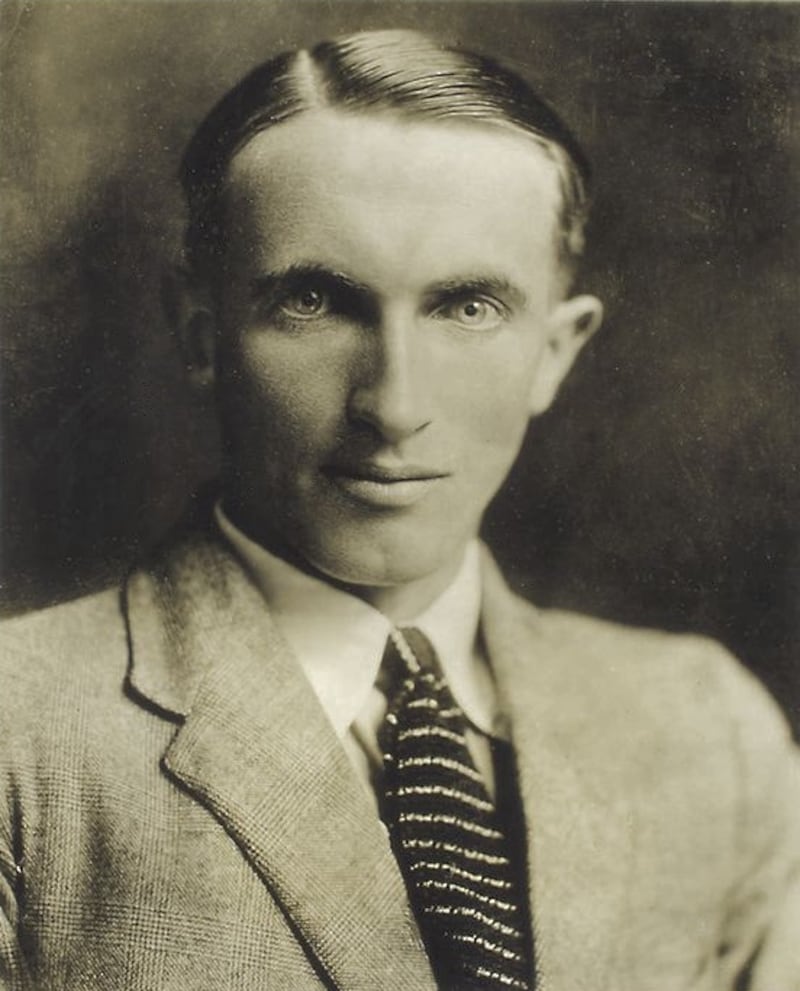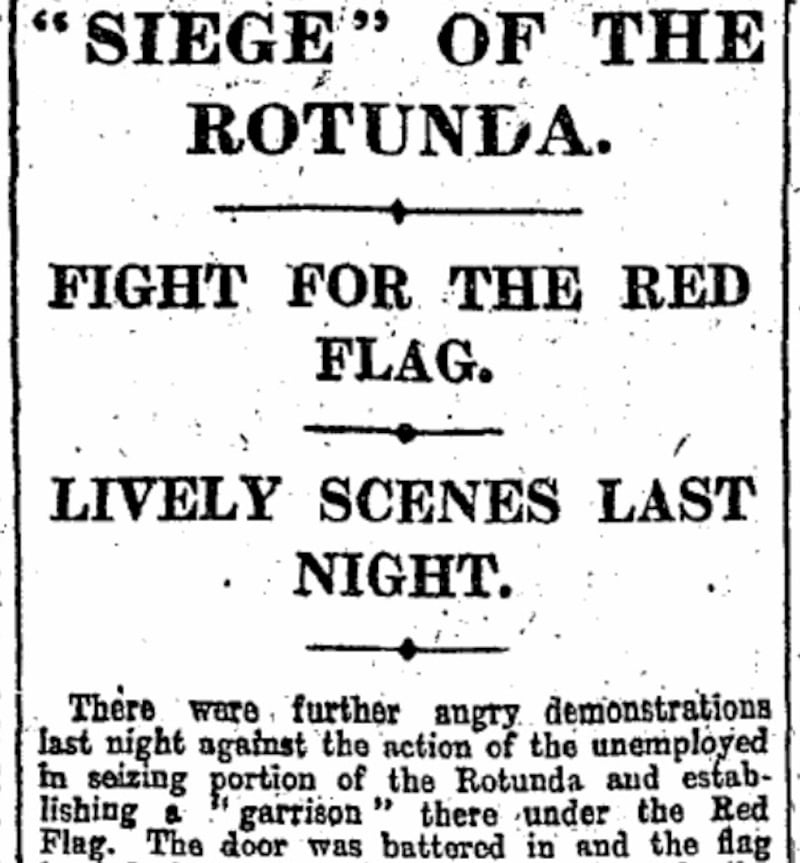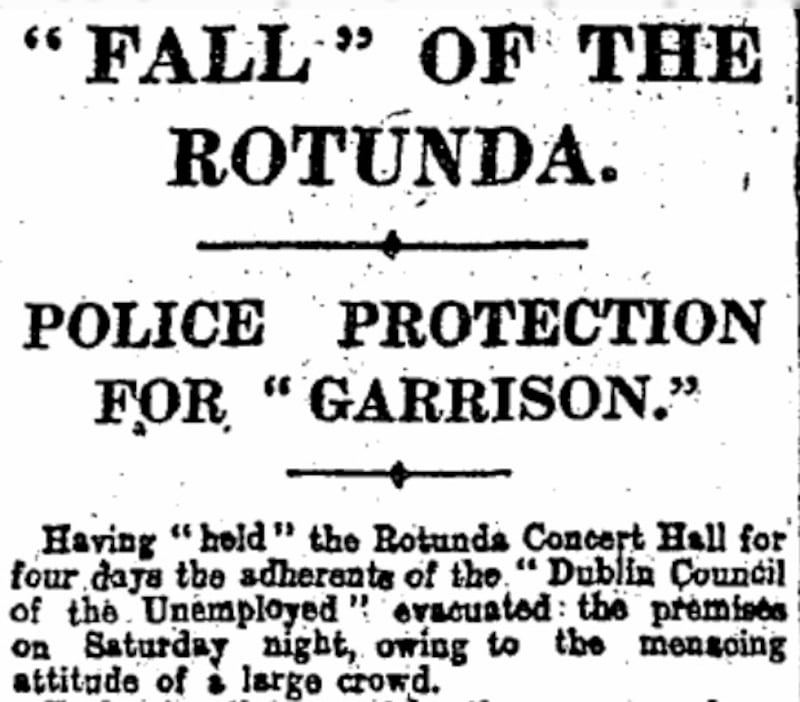"The unemployed in Dublin have seized the concert room at the Rotunda," begins an Irish Times report on the morning of Thursday, January 19th, 1922, the day after a large group of out-of-work men occupied the building at the north end of Dublin's O'Connell Street.
Unfurling the red flag from a window, they declared they would hold their position until they were removed “as a protest against the apathy of the authorities”.
The Anglo-Irish Treaty was not long signed and the Provisional Government was just a couple of days old when the group – described in reports as a “garrison” divided into “companies”, each with its “officers” – took control of the building in an early act of defiance towards the Irish Free State.
The men had arranged to use the concert room for one day, but announced their true intentions on arrival. Mr Kaye, the manager of the hall – which the adjacent maternity hospital took its name from – attempted to contact the Lord Mayor, but he was departing for Paris. That was a Wednesday.
The leader of the 120-strong group was an out-of-work former soldier named Liam O'Flaherty. Then involved in radical politics and a founding member of the Communist Party of Ireland, he would go on to become one of Ireland's leading 20th century novelists and short story writers.

"We told him (Mr Kaye) that he could send for the police to eject us if he liked and we decided that if they came, no resistance was to be offered, but that they could carry us out in their arms to their Black Marias if they liked," O'Flaherty told an Irish Times reporter at the scene on the day of the occupation.
“If we were taken to court we would not recognise the court, because the Government that refuses to redress our grievances is not worth recognising.”
O’Flaherty – then chairman of the Council of Unemployed – told the reporter there were 12,500 unemployed in Dublin. With women and children, that number was 30,000, he said. They intended to stay put until the local authorities made some move toward providing work for all who needed it.
O’Flaherty issued perhaps his earliest literary venture: a Manifesto to the Citizens of Dublin, asking for residents’ support. It asked: “Do the citizens of Dublin want highway robbery to be the order of the day? Do they want chaos and anarchy? If not, let them rally to the support of the Dublin Council of Unemployed, and procure work for the workless, and maintenance until work is supplied.”
"A visit to the hall was interesting," wrote the Irish Times reporter, evidently surprised at the level of organisation: "Inside the door the 'guard' was mounted, and the visitor was escorted by one of its members to the 'officer commanding'. At each door sentries were on duty, and these sprang to attention and saluted as the 'CO' passed through."
And organised they were. The men were divided into four companies, each of which provided sentries, posted at various points. A makeshift police force was also formed.
Cheerful spirits
It wasn’t all business. The men trained at night, but with the odd “impromptu concert” held. “There was some music and dancing in another part of the hall, while around the fire gathered a large body – all apparently in very cheerful spirits.”
On the second day of the occupation, the group's internal disciplinary functions were also put to use: "We had a court martial this morning," an Irish Times reporter was told, "on an officer, and we reduced him to the ranks, for disobeying orders."
Reactions to the occupation were mixed. In support of the men, a fund was established and contributions amounting to £6 had been collected by day two. Boland’s bakery donated 500 loaves of bread to the cause.
As the days went by, hostile counter-protesters gathered en masse, and violence threatened to break out. Friday night was something of a boiling point.
The Irish Times reported: "As the evening wore on the crowd outside which was manifestly hostile to the out-of-works, grew in numbers and at intervals threatened to get out of hand.
“The Red Flag seemed to affect many of them as it would a bull and derisive taunts were hurled at the ‘garrison’ inside, which had taken the precaution of barricading the door and closely shuttering the windows.”

An attempt was made to capture the flag, but the daring climber of the portico fell to the pavement and had to be taken to Jervis street hospital. Not long after his failure, another man made a successful attempt, ripping the fabric from its stick and putting it in his pocket, to cheers from the crowd below.
The flag was quickly replaced by the besieged, “but it was a poor specimen as compared with the first one”.
At 10.30pm, the barrier was breached, and men armed with poles and planks made it into the concert room. “Again the police had to intervene, and after a short time removed the attackers from the hallway, no collision having occurred between them and any of the ‘garrison’.”
The Irish Times praised the Dublin Metropolitan Police and the Republican Police for keeping the peace that night. Eventually, a cordon was formed and the crowd dispersed.
The only casualty throughout the demonstration was an injury to one of the occupiers, who was set upon on Cavendish Row as he returned to the Rotunda. The crowds there “relieved him of the provisions and assaulted him, inflicting a wound on his mouth, for which he found it necessary to obtain treatment in hospital.”
After four days, the occupation ended without incident. The headline the following Monday in The Irish Times ran: "FALL" OF THE ROTUNDA.

The evacuation happened at about midnight on Saturday, following another evening of hostility during which shots had been fired over the heads of the mob outside the Rotunda. The occupiers eventually relented; the unemployed men were allowed leave by the side exit of the building in batches and walked away quietly into the city.
The crowd then dispersed, putting an end to one of the lesser-remembered episodes in the months following the signing of the Anglo-Irish Treaty.










